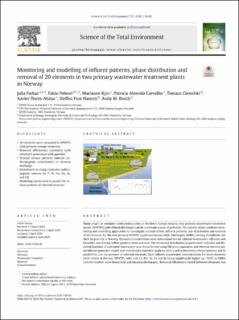| dc.contributor.author | Farkas, Julia | |
| dc.contributor.author | Polesel, Fabio | |
| dc.contributor.author | Kjos, Marianne Steinsvik | |
| dc.contributor.author | Almeida Carvalho, Patricia | |
| dc.contributor.author | Ciesielski, Tomasz Maciej | |
| dc.contributor.author | Flores-Alsina, Xavier | |
| dc.contributor.author | Hansen, Steffen Foss | |
| dc.contributor.author | Booth, Andy | |
| dc.date.accessioned | 2020-05-07T07:43:16Z | |
| dc.date.available | 2020-05-07T07:43:16Z | |
| dc.date.created | 2020-04-10T15:19:13Z | |
| dc.date.issued | 2020-07-10 | |
| dc.identifier.citation | Science of the Total Environment. 2020, 725 138420-?. | en_US |
| dc.identifier.issn | 0048-9697 | |
| dc.identifier.uri | https://hdl.handle.net/11250/2653566 | |
| dc.description.abstract | Many small- or medium-sized communities in Northern Europe employ only primary wastewater treatment plants (WWTPs) and effluent discharges can be a relevant source of pollution. The current study combines monitoring and modelling approaches to investigate concentrations, influent patterns, size distribution and removal of 20 elements for the two primary WWTPs (Ladehammeren, LARA; Høvringen, HØRA) serving Trondheim, the third largest city in Norway. Element concentrations were determined in raw influent wastewater, effluents and biosolids, and diurnal inflow patterns were assessed. The elemental distribution in particulate, colloidal and dissolved fractions of untreated wastewater was characterized using filtration separation and electron microscopy. An influent generator model and multivariate statistical analyses were used to determine release patterns and to predict the (co-)occurrence of selected elements. Raw influent wastewater concentrations for most elements were similar in the two WWTPs, with only Ca, Mn, Fe, Co and Ba being significantly higher (p<0.05) in HØRA (which receives more household and hospital discharges). Removal efficiencies varied between elements, but in most cases reflected their association with particulates. Nanosized particles of several elements were detected, with Cu/Zn being most common. Measured concentrations of most elements followed typical diurnal wastewater discharge patterns and enrichment factors calculated for biosolids confirmed the importance of anthropogenic sources for P, Cu, Zn, Cd, As, Cr, Ni, Pb, V, Co and Fe. Elemental concentrations generally correlated well with total suspended solid (TSS) concentrations at HØRA, while this was less pronounced in LARA (possibly due to higher industrial contributions). In one of its first applications for WWTP influent pattern examination, principal component analysis was found to be instrumental for source identification of target elements, showing significant differences between LARA and HØRA influents. The combined experimental, statistical and modelling approaches used herein allowed for improved understanding of element sources, patterns of discharge and fate in primary WWTPs. | en_US |
| dc.language.iso | eng | en_US |
| dc.publisher | Elsevier Ltd | en_US |
| dc.rights | Navngivelse 4.0 Internasjonal | * |
| dc.rights.uri | http://creativecommons.org/licenses/by/4.0/deed.no | * |
| dc.subject | Elements | en_US |
| dc.subject | Wastewater treatment | en_US |
| dc.subject | Removal | en_US |
| dc.subject | Characterization | en_US |
| dc.subject | Principal component analysis | en_US |
| dc.subject | Modelling | en_US |
| dc.title | Monitoring and modelling of influent patterns, phase distribution and removal of 20 elements in two primary wastewater treatment plants in Norway | en_US |
| dc.type | Journal article | en_US |
| dc.type | Peer reviewed | en_US |
| dc.description.version | publishedVersion | en_US |
| dc.rights.holder | © 2020 The Authors. Published by Elsevier B.V. | en_US |
| dc.source.pagenumber | 138420 | en_US |
| dc.source.volume | 725 | en_US |
| dc.source.journal | Science of the Total Environment | en_US |
| dc.identifier.doi | 10.1016/j.scitotenv.2020.138420 | |
| dc.identifier.cristin | 1805819 | |
| dc.relation.project | Norges forskningsråd: 238972 | en_US |
| cristin.ispublished | true | |
| cristin.fulltext | original | |
| cristin.qualitycode | 2 | |

